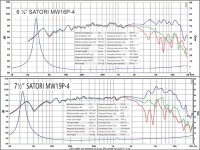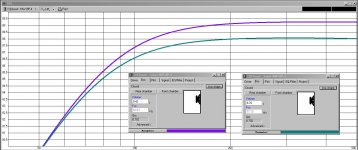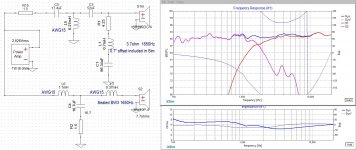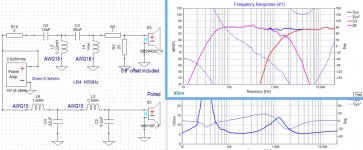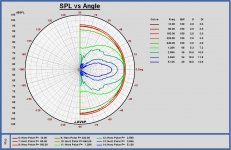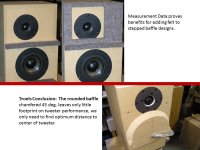4.5L sealed? Why would you spend big money on a 6.5" SB Satori drive unit and fit it into such a small box?
Our member Gornir has done a lot of work with this driver.
www.audioexcite.com Satori Two – Monitor
It's also in "similar threads" at the bottom of the page. Joachim Gerhard is another person familiar with it.
http://www.diyaudio.com/forums/vendors-bazaar/220330-sb-acoustics-satori-monitor.html
Our member Gornir has done a lot of work with this driver.
www.audioexcite.com Satori Two – Monitor
It's also in "similar threads" at the bottom of the page. Joachim Gerhard is another person familiar with it.
http://www.diyaudio.com/forums/vendors-bazaar/220330-sb-acoustics-satori-monitor.html
MW19P vs. MW16P SPL, Sealed Box
I build 3-way speakers with a sealed box midbass covering the vocal range 80Hz-1100Hz, and found the Satori MW19P-4 to be an excellent fit for my goals.
The larger 7.5" Satori MW19P-4 has a similar SPL/freq curve to the 6.5" MW16P-4 which support a 1,650Hz BW3 crossover, but with ~1.3db higher sensitivity in sealed midbass alignments, plus 40cm^2 larger Sd(34%) to move more air. The T/S parameter are better suited for a true sealed midbass. Just add a Musical Woofer.
MW19P rev3 has Qtc=0.7 in 9.4l with -F3=85Hz and 89.2db sensitivity
MW16P rev3 has Qtc=0.7 in 8.7l with -F3=77Hz and 88.0db sensitivity
The MW19P could be another option for your sealed design.
I build 3-way speakers with a sealed box midbass covering the vocal range 80Hz-1100Hz, and found the Satori MW19P-4 to be an excellent fit for my goals.
The larger 7.5" Satori MW19P-4 has a similar SPL/freq curve to the 6.5" MW16P-4 which support a 1,650Hz BW3 crossover, but with ~1.3db higher sensitivity in sealed midbass alignments, plus 40cm^2 larger Sd(34%) to move more air. The T/S parameter are better suited for a true sealed midbass. Just add a Musical Woofer.
MW19P rev3 has Qtc=0.7 in 9.4l with -F3=85Hz and 89.2db sensitivity
MW16P rev3 has Qtc=0.7 in 8.7l with -F3=77Hz and 88.0db sensitivity
The MW19P could be another option for your sealed design.
Attachments
Last edited:
MW19P vs. MW16P SPL, Sealed Box
I build 3-way speakers with a sealed box midbass covering the vocal range 80Hz-1100Hz, and found the Satori MW19P-4 to be an excellent fit for my goals.
The larger 7.5" Satori MW19P-4 has a similar SPL/freq curve to the 6.5" MW16P-4 which support a 1,650Hz BW3 crossover, but with ~1.3db higher sensitivity in sealed midbass alignments, plus 40cm^2 larger Sd(34%) to move more air. The T/S parameter are better suited for a true sealed midbass. Just add a Musical Woofer.
MW19P rev3 has Qtc=0.7 in 9.4l with -F3=85Hz and 89.2db sensitivity
MW16P rev3 has Qtc=0.7 in 8.7l with -F3=77Hz and 88.0db sensitivity
The MW19P could be another option for your sealed design.
Hi!
Im looking for sealed 2-way to be placed in top of my 220L/7.7cu ft JBL2226H subwoofers (design is Stig Erik Tangen´s Almighty subwoofers)
Ill plan to use LR4 100hz.
Could you share more details about your MW19P sealed design?
With a 15" woofer using LR4 electronic crossover, also using LR4 passive crossover circuits on the midrange and tweeter will produce a better impulse and square wave response. Using a large baffle with strong edge control removes the need to compensate for the 1-3db edge diffraction gain produced between 400-1.5kHz by small baffles. A 1cuft sealed volume will produce Qtc ~ 0.5
Linkwitz-Riley crossovers:
1. Flat amplitude response through out the passband with a steep 24 dB/octave rolloff rate after the crossover point.
2. The acoustic sum of the two driver responses is unity at crossover. (Amplitude response of each is -6 dB at crossover, i.e., there is no peaking in the summed acoustic output)
3. Zero phase difference between drivers at crossover. (Lobing error equals zero, i.e., no tilt to the polar radiation pattern.) In addition, the phase difference of zero degrees through crossover places the lobe of the summed acoustic output on axis at all frequencies.
4. The low pass and high pass outputs are everywhere in phase. (This guarantees symmetry of the polar response about the crossover point)
5. All drivers are always wired the same (in phase).
BUT.. A Linkwitz-Riley crossover alignment is not linear phase: meaning that the amount of phase shift is a function of frequency.
Linkwitz-Riley crossovers:
1. Flat amplitude response through out the passband with a steep 24 dB/octave rolloff rate after the crossover point.
2. The acoustic sum of the two driver responses is unity at crossover. (Amplitude response of each is -6 dB at crossover, i.e., there is no peaking in the summed acoustic output)
3. Zero phase difference between drivers at crossover. (Lobing error equals zero, i.e., no tilt to the polar radiation pattern.) In addition, the phase difference of zero degrees through crossover places the lobe of the summed acoustic output on axis at all frequencies.
4. The low pass and high pass outputs are everywhere in phase. (This guarantees symmetry of the polar response about the crossover point)
5. All drivers are always wired the same (in phase).
BUT.. A Linkwitz-Riley crossover alignment is not linear phase: meaning that the amount of phase shift is a function of frequency.
Attachments
With a 15" woofer using LR4 electronic crossover, also using LR4 passive crossover circuits on the midrange and tweeter will produce a better impulse and square wave response. Using a large baffle with strong edge control removes the need to compensate for the 1-3db edge diffraction gain produced between 400-1.5kHz by small baffles. A 1cuft sealed volume will produce Qtc ~ 0.5
Linkwitz-Riley crossovers:
1. Flat amplitude response through out the passband with a steep 24 dB/octave rolloff rate after the crossover point.
2. The acoustic sum of the two driver responses is unity at crossover. (Amplitude response of each is -6 dB at crossover, i.e., there is no peaking in the summed acoustic output)
3. Zero phase difference between drivers at crossover. (Lobing error equals zero, i.e., no tilt to the polar radiation pattern.) In addition, the phase difference of zero degrees through crossover places the lobe of the summed acoustic output on axis at all frequencies.
4. The low pass and high pass outputs are everywhere in phase. (This guarantees symmetry of the polar response about the crossover point)
5. All drivers are always wired the same (in phase).
BUT.. A Linkwitz-Riley crossover alignment is not linear phase: meaning that the amount of phase shift is a function of frequency.
Thanks!
I can use other slopes as well with DLCP dsp. Jeff Bagby uses 200hz crossover for woofer modules for his Kairos speakers.
But finding large, sealed 2-way designs is difficult, found just one 2-way build for MW19P:
MW19P-8
Im considering it in sealed cabinet.
Are you happy with your 2-way with MW19P and is your plans available?
x) There is a typo on my Xsim schematic. I correctly used FRD and ZMA data for the MW19P-4 simulation, but typed MW16P-4 on the schematic in error.
x) Note that Troels Gravesen also used an LR4 circuit on the MW19P-8 in his SBA MW19 Studio Monitor, and explains his reasons in the design write-up. If you decide to build a stepped baffle for time alignment like Troel, it would be simple to put a similar LR2 circuit on the tweeter.
x) If you match the width of your new MW19P cabinet to your existing Tangen Almighty subwoofer you should get lower diffraction and baffle step effects than from the typical sharp-edged 10" wide box. To reduce diffraction you should still consider mounting the tweeter about 1" off-center, beveling the new TM cabinet's top corners into a truncated pyramid(Avalon style), or quarter-round the edges with your router.
x) I used the 0.7cuft cabinet from Parts Express H17",W10",D12.5"
x) Many vocals have subtle details mixed with dynamic instruments which the MW19P covers without crossovers or beaming.
x) Note that Troels Gravesen also used an LR4 circuit on the MW19P-8 in his SBA MW19 Studio Monitor, and explains his reasons in the design write-up. If you decide to build a stepped baffle for time alignment like Troel, it would be simple to put a similar LR2 circuit on the tweeter.
x) If you match the width of your new MW19P cabinet to your existing Tangen Almighty subwoofer you should get lower diffraction and baffle step effects than from the typical sharp-edged 10" wide box. To reduce diffraction you should still consider mounting the tweeter about 1" off-center, beveling the new TM cabinet's top corners into a truncated pyramid(Avalon style), or quarter-round the edges with your router.
x) I used the 0.7cuft cabinet from Parts Express H17",W10",D12.5"
x) Many vocals have subtle details mixed with dynamic instruments which the MW19P covers without crossovers or beaming.
Attachments
x) There is a typo on my Xsim schematic. I correctly used FRD and ZMA data for the MW19P-4 simulation, but typed MW16P-4 on the schematic in error.
x) Note that Troels Gravesen also used an LR4 circuit on the MW19P-8 in his SBA MW19 Studio Monitor, and explains his reasons in the design write-up. If you decide to build a stepped baffle for time alignment like Troel, it would be simple to put a similar LR2 circuit on the tweeter.
x) If you match the width of your new MW19P cabinet to your existing Tangen Almighty subwoofer you should get lower diffraction and baffle step effects than from the typical sharp-edged 10" wide box. To reduce diffraction you should still consider mounting the tweeter about 1" off-center, beveling the new TM cabinet's top corners into a truncated pyramid(Avalon style), or quarter-round the edges with your router.
x) I used the 0.7cuft cabinet from Parts Express H17",W10",D12.5"
x) Many vocals have subtle details mixed with dynamic instruments which the MW19P covers without crossovers or beaming.
Hi!
Thanks again. To be honest, I dont understand speaker design so well that could make decisions from your data or make custom XO with similar width baffle like my subs. I think Ill stick in Jeff Bagby Kairos design (sealed)
- Status
- This old topic is closed. If you want to reopen this topic, contact a moderator using the "Report Post" button.
- Home
- Loudspeakers
- Multi-Way
- 2 way for SB Acoustics “Satori” MW16P-4 mid-woofer
